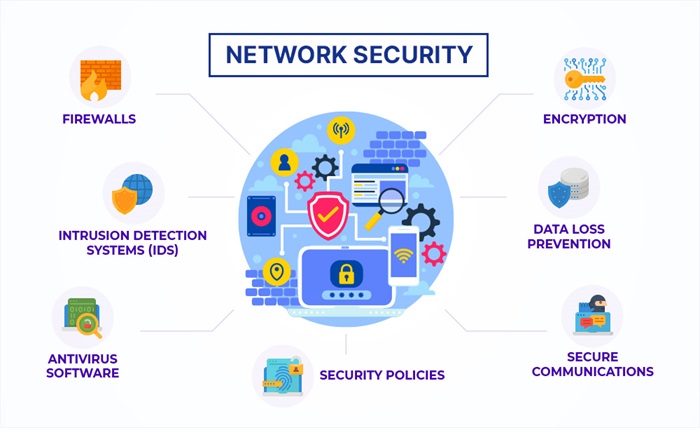Table of Contents
- What Are Network Security Vulnerabilities?
- Common Types of Vulnerabilities
- Best Practices for Mitigation
- Importance of Regular Updates
- Training and Awareness
- Leveraging Security Tools
- Incident Response Plans
- Future Trends in Network Security
What Are Network Security Vulnerabilities?
Vulnerabilities or shortcomings in a system that an attacker can use to obtain unauthorized access to data or interfere with services are known as network security vulnerabilities. These weaknesses may be present in software, hardware, or even human performance. They pose serious business risks because they can result in financial harm, sensitive data loss, and breaches. For instance, you can explore Fortinet CVEs on CVEDetails.com to find specific examples. Organizations can proactively maintain a secure network environment and protect against potential threats by understanding and addressing these weaknesses.
Common Types of Vulnerabilities
There are various types of network vulnerabilities that organizations need to watch out for:
- Software Bugs: Flaws in coding that create loopholes. These bugs can be as minor as causing service disruptions or as severe as allowing remote code execution by an attacker.
- Default Passwords: Weak, factory-set passwords that are easily guessed. Many devices have default passwords that are well-known to attackers, making it easy for them to gain unauthorized access.
- Configuration Flaws: Incorrect system setup that can be exploited. Simple misconfigurations, like leaving sensitive ports open, can provide easy entry points for cybercriminals.
- Lack of Encryption: Data transmitted without encryption is vulnerable to interception. Attackers can easily read unencrypted data, leading to breaches of confidential information.
Best Practices for Mitigation
Regular System Audits
Performing regular system audits can help identify and rectify vulnerabilities early. An in-depth audit should cover hardware and software systems and involve thorough testing and review. By systematically checking systems, organizations can discover weaknesses before attackers exploit them.
Implementing Strong Password Policies
Mandating complex and unique passwords can significantly reduce the risk of unauthorized access. Password policies should enforce the use of a combination of letters, numbers, and special characters and require periodic password changes to stay ahead of potential threats.
Using Multi-factor Authentication
Multi-factor authentication adds a layer of security by requiring a password and a secondary verification form, such as a mobile app code or fingerprint scan. This makes it much harder for attackers to gain access, as they must compromise multiple authentication factors.
Employing Intrusion Detection Systems
Intrusion Detection Systems (IDS) monitor network traffic for suspicious activities and alert administrators to potential threats. These systems can detect unusual patterns or behaviors that may indicate an attempted breach. IDS is an essential tool in the modern cybersecurity arsenal, offering real-time monitoring and defensive measures to counter attacks.
Importance of Regular Updates
Regularly updating software and systems is critical in patching known vulnerabilities. Outdated software is a common entry point for cyber attacks, as attackers often exploit well-known flaws already addressed in updates. Keeping your systems updated ensures they have the latest security enhancements and bug fixes, minimizing the risk of exploitation.
Training and Awareness
The first line of defense is frequently the workforce. Staff members can recognize possible threats and comprehend their responsibilities for preserving network security through regular training and awareness sessions. Employee education on common phishing attacks, the value of secure password usage, and how to handle sensitive data appropriately can help considerably lower the likelihood that human error will result in security breaches. Awareness programs can also include simulated attacks to test and improve employees’ readiness.
Leveraging Security Tools
Security tools like firewalls, anti-virus software, and vulnerability scanners are essential. These instruments offer extra defense against different types of attacks. Firewalls, for example, stand as barriers between trusted and untrusted networks to prevent unwanted access. Vulnerability scanners, on the other hand, automate the process of finding security flaws in your systems and offer practical security recommendations.
Forbes experts recommend integrating these tools to create a robust security framework to protect against ever-evolving risks. Combining multiple security tools creates a multi-layered defense strategy that can adapt to and counteract sophisticated attacks.
Incident Response Plans
In a security breach, prompt action is ensured by an efficient incident response plan. Steps for locating the threat, containing it, eliminating it from the system, and restoring regular operations should all be included in the plan. Teams can remain prepared and react effectively in the event of an incident by practicing regularly. The impact of a breach can be considerably lessened, and recovery efforts can be accelerated with a well-defined incident response protocol. In addition, a robust incident response plan should include clear communication channels to inform key stakeholders, including executives, legal teams, and affected customers, as needed. Regular updates to the plan are crucial, as they ensure that new threats and vulnerabilities are accounted for, keeping the strategy current. By incorporating post-incident reviews, organizations can learn from each breach, identifying areas for improvement and further strengthening their defenses.
Future Trends in Network Security
Network security is a constantly changing field. More secure systems may be possible thanks to cutting-edge developments like quantum encryption and AI-driven defenses. Businesses increasingly turn to artificial intelligence to anticipate and neutralize threats before they can harm by sifting through massive volumes of data and spotting patterns that point to malevolent activity.
On the other hand, quantum encryption promises to provide unbreakable encryption techniques that may supersede existing encryption standards. This innovation adds a new degree of security to data transmission by using the ideas of quantum mechanics to generate encryption keys that are nearly hard to decipher.



